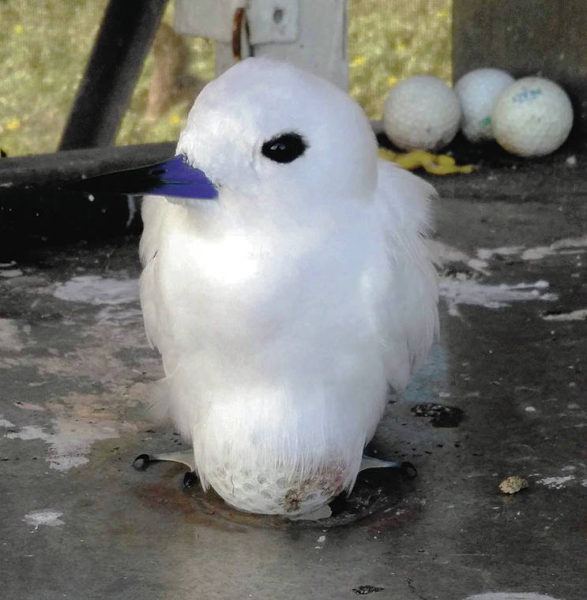Published in the Ocean Watch column, Honolulu Star-Advertiser © Susan Scott
January 18, 2020
My month of working at Midway Atoll as a volunteer bird counter for the U.S. Fish and Wildlife Service ended Friday. As always, when I arrive home on Oahu after a Midway stint, I feel as if I just stepped out of a Dr. Seuss book. We humans might not understand their language, but Midway’s seabirds and shorebirds constantly tell their stories.
One albatross story is plastic. The birds can’t explain why they pick up bits of plastic floating on the ocean’s surface, but one theory is that it’s no mistake. Because a million or so albatrosses are successfully raising chicks at Midway and in other Hawaii wildlife refuges, it’s possible (some biologists think probable) that some drifting plastic pieces hold flying fish eggs, a significant part of the albatross diet.
 Midway had a golf course during its military tenure, so golf balls
Midway had a golf course during its military tenure, so golf balls
turn up here and there. A white tern was found incubating
one that had rolled to the center of a Midway workbench.
Courtesy Nattapon Songserm
Flying fish attach their sticky egg strings to objects floating on the surface of the ocean. Traditionally, the objects were driftwood, seaweeds and pumice, a porous volcanic rock. Today we’ve added plastic to the mix.
In addition to eating fish and squid, albatrosses also look for surface items containing the nutritious fish eggs. The birds evolved to digest such food and vomit up the nonfood, such as squid beaks, wood and plastic. This adaptation might explain why we see so many bottle caps and other plastic pieces around albatross nests. The chicks have thrown up what they can’t absorb.
This is not to say that plastic is good for the birds or that they’re able to throw it all up. It’s just that, as with most wildlife stories, photos of dead birds full of plastic is just one chapter in a complex plot.
The kolea’s story here is probably one of predator and prey. Unlike albatrosses, which evolved with no predators in their nesting grounds, Pacific golden plovers raise their chicks on Alaska’s tundra. Foxes, falcons, gulls, weasels and even caribou prey on plover parents, eggs and chicks, making the shorebirds wary of the slightest movement.
Most of the kolea at Midway have never seen people before landing there, and the birds aren’t inclined to let down their guard.
The fact that so many kolea live in harmony with humans in Hawaii’s urban areas makes our main Hawaiian Island birds all the more special. Why they seem so tame here, and act so skittish in other places, is a secret only the birds know.
No fantastic story collection would be complete without fairies, the fairies at Midway being white terns. At approximately 50,000 strong, the fluttering white birds dominate the ironwood trees here, hovering above our heads with calls that resemble a string instrument. We like to believe the little birds are curious, but I think that at least one bird was saying, “Come quick! My crazy wife is sitting on a golf ball!”
The epilogue to my Midway story is to answer several readers’ questions about how one can visit Midway. Currently, the only way is to volunteer for the U.S. Fish and Wildlife Service. It’s expensive to get here, the work is long and hard and volunteer slots are few. But to step even briefly into a real live Dr. Seuss story is worth whatever it takes.